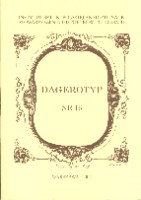A jednak Mieczkowski! O problemach z atrybucją niesygnowanych fotografii
It is Mieczkowski, after all! On the problems of attributing unsigned photographs
Author(s): Danuta JackiewiczSubject(s): Photography
Published by: Instytut Sztuki Polskiej Akademii Nauk
Keywords: Beyer; Karol; Mieczkowski; Jan; Warsaw; Old Town; attributing; photography; Polish photography; vintage photography; old photographic technique
Summary/Abstract: This article is concerned with a photograph of the Piwna Street in Warsaw with the characteristic bird sellers’ cages exposed outside the houses (ill. 1). The author of this article had previously attributed this photograph to Karol Beyer (D. Jackiewicz, Sztuka fotografii. Portret, pejzaż, reportaż w fotografii polskiej XIX wieku. Katalog wystawy, Warszawa 1990, cat. no. 127), and this attribution became accepted in the subject literature (W. Mossakowska, Początki fotografii w Warszawie (1839-1863), Warszawa 1994, vol. I, pp. 80, 109). The photograph was reproduced using the woodcut technique in the illustrated weekly Kłosy on the 26th July 1865 (ill. 2). The accompanying caption informed that the trade in birds had just been moved from Zapiecek Street to Piwna Street. Together, this allowed the dating of the photograph to July 1865 at the latest. Still, however, nothing was known about its author. Another copy of this photograph has recently been discovered in the archives of the National Museum in Warsaw. Below the photograph, on a cardboard background is a printed text: „Fotogra: Jan Mieczkowski | w Warszawie.” (ill. 3). In this way it became known that the authorship is other than what had previously been thought. This can also be applied to the photograph „Market on the Old Town Square” (ill. 4), also previously attributed to Beyer (Jackiewicz, Ibid., cat. no. 128; Mossakowska, Ibid., vol. I, pp. 80-81, vol. II, ill. 73). Its „painterly retouch”, similar to that on the photograph of Piwna Street, allows us to suspect that we are also dealing here with the work of the Warsaw photographer Jan Mieczkowski. On the basis of this example, the author analysed the problems of attributing unsigned photographs, especially early photographs from the third quarter of the nineteenth century. If one does not have access to other copies of the same photograph with the photographer’s signature provided (handwritten signature, facsimile of the signature, an ink or dry stamp of the photograph laboratory, the laboratory’s company overprint on the front or back of the cardboard background), neither access to its reproduction in a periodical giving the name of the author, nor to an archival record, a series of considerations should be taken into account, and conclusions should be reached on the basis of the technical analysis of the object in question. The following are significant: the method of composing and operating light, the shade of the copy and its retouching, fragments of the photographic atelier which may be visible on the photograph, the themes dealt with by the photographer according to which one might presume that he could be author of the photograph. Knowledge about the collector from whose collection the photograph comes could also be helpful, amongst other things concerning his preferences and contacts in the photographic community, and also concerning his travels and the history of his collection.
Journal: Dagerotyp
- Issue Year: 2004
- Issue No: 13
- Page Range: 5-12
- Page Count: 8
- Language: Polish
- Content File-PDF

